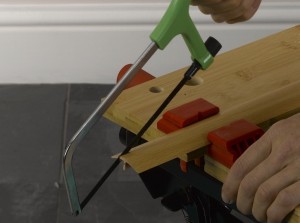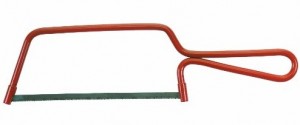Junior hacksaws
A junior hacksaw is a seldom used, but still essential part of any DIY toolkit. It tends to knock around at the bottom of your toolbox, rarely sees daylight, and only pops out on the odd occasion before disappearing back down into the depths of toolbox oblivion. However, any self respecting DIY enthusiast simply can’t do without it, as although a junior hacksaw is not an everyday tool, there are just some jobs you come across, where it’s always going to be the ideal choice.
What about ‘Big’ hacksaws?
Hacksaws are very fine toothed saws designed for cutting metal, and to a certain extent, plastics. Large hacksaws, have nearly become obsolete as far as DIY is concerned because of the invention of tools like angle grinders and power saws, which now carry out many of those jobs that the hacksaw used to do. So how does the junior hacksaw still have a place? Well quite simply, because it is small, accurate with practise, and literally takes up no room in a toolbox. It can also carry out jobs that larger hacksaws may once have been used for, as quality junior hacksaws can easily punch above their weight, so why carry around a large hacksaw, when your little one is ready and waiting in your toolbox?
Junior hacksaw jobs
Here are a selection of jobs that may be infrequent, but always get me reaching for my junior hacksaw.

A junior hacksaw is the perfect tool for cutting a door threshold strip to size.
- Cutting down metal spindles -Â When fitting a door with new handles, invariably, the new handle set is supplied with a spindle (the bar that goes through the door connecting the two handles) that is too long for the thickness of your door, and you can’t use the old spindle with your new handles as they are of a slightly different size. Now, you could buy a large hacksaw to cut them down, but why bother, when your toolbox junior hacksaw is more than capable?
- Cutting through a copper pipe – As a rule, it’s always best to use pipe cutters or pipe slices for cutting down copper tube/pipe. However, there are some situations where space is tight, pipe cutters, or slices, simply won’t wrap around the pipe, and so the only tool to use is a junior hacksaw.
- Cutting a door threshold – Accurate cutting of a metal, plastic, or wooden threshold is an important finishing touch to any new floor. A junior hacksaw provides a precise neat cut, ensuring the best possible finish.
- Cutting curtain tracks – Junior hacksaws are quite simply, the ideal tool for cutting a curtain track to length, before fixing it above a window.
- Cutting roller blinds to size – Staying with the window dressing theme, you always need a junior hacksaw to cut the roller section to the correct length, whether it be metal tubing or wooden dowel.
- Draught excluders – All wooden, metal and plastic draught excluders, are best cut to size with a junior hacksaw.
My hacksaw choice

Bahco junior hacksaws are simple, well made, inexpensive, and the only hacksaw you’ll probably ever need.
Most junior hacksaws will do ‘the job’, but many break all too quickly, because as ridiculous as it sounds, many manufacturers have simply tried to over-engineer them. They’ve added ergonomic handles, little screws for tightening the blade tension, pistol-type grips etc. – all of which, really aren’t necessary, as the original, simple design, is all that is required.
Basically there is nothing that can go wrong with the original metal frame design, it is beyond simple to change the blade, and there is no part that can break (other than the blade of course!). So, for me, a good quality simple metal frame design, with some hardened steel blades is all I will ever need.
On Amazon, you can buy a Bahco 239 Junior Sawfor less than a fiver, with a pack of the best quality blades, again, for under five pounds. Add them to your toolbox today, so they are ready and waiting for all those little DIY jobs where a junior hacksaw is the ideal choice of tool.
